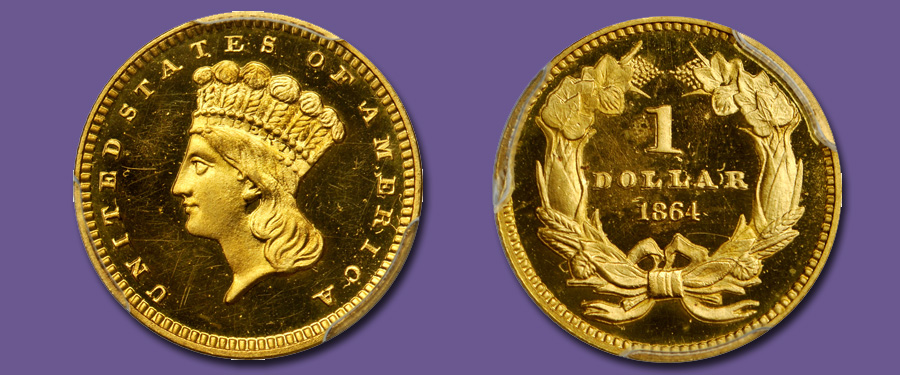
Following the success of Christopher Bechtler’s privately issued gold dollar first struck in 1831, engraver Christian Gobrecht conceived a gold dollar pattern in 1836, now known as Judd-67. However, it wouldn’t be until after the discovery of gold in California in 1848, that the U.S. Mint would formally strike a gold dollar for circulation. Authorized by the Act of March 3, 1849, the minting of the gold dollar faced much deliberation concerning size and format (both annular and bimetallic formats were considered). Convention trumped innovation and a standard planchet was chosen.
Destined for a 13-millimeter canvas, Chief Engraver James B. Longacre’s initial design for the 1949 gold dollar depicted the head of Liberty facing left with a coronet, inspired by the Greco Roman archetype of Venus Accroupie, or crouching Venus. After striking the first 1,000 coins, the dies cracked and the design was slightly revised, contributing to several variations in wreath format and the presence of Longacre’s “L” initial that are popular among collectors today.
The gold dollar was largely well-received by the American public for its favorable gold-to-silver ratio and its practicality. In 1854, the gold dollar was enlarged to 15mm and made thinner, though it retained the same weight. Now featuring Longacre’s Indian Princess motif, the Type II dollar was struck beginning in August of 1854, making it a transitional issue. Because of the thinner planchets, thorough rendering of the devices was challenging on Type II dollars, making well-struck examples quite elusive.
In 1856, the motif was again slightly altered to exhibit a larger head, and the legend was moved closer to the edge to improve striking quality. This Type III design would remain in production until the conclusion of the gold dollar series in 1889. Circulation-strike examples are readily available, and a representative Proof can be acquired without too much exertion. However certain Proof issues surrounding the Civil War years present a significant challenge to collectors. With most mintages ranging from just 20 to 50 pieces, these Type III Proofs are in short supply relative to demand, adding to the desirability of this exquisite Proof-64 Deep Cameo piece.
The Deep Cameo contrast immediately greets the viewer across both sides, with mirrored fields sharply juxtaposed with the satiny, untouched devices. The design elements are well outlined, with a remarkable delineation noted on the reverse. The eye appeal of this piece is astonishing.
This near-Gem Proof will be offered in our March 2016 Rarities Night session, held in conjunction with our Official Auction of the Whitman Coin & Collectibles Spring Expo in Baltimore. To consign your treasures to this sale, or any other of our auctions, please contact our offices today at 1-800-458-4646 to speak with a Consignment Director and see what Stack’s Bowers can do for you.





